1999 FORD CROWN VICTORIA transmission
[x] Cancel search: transmissionPage 159 of 208
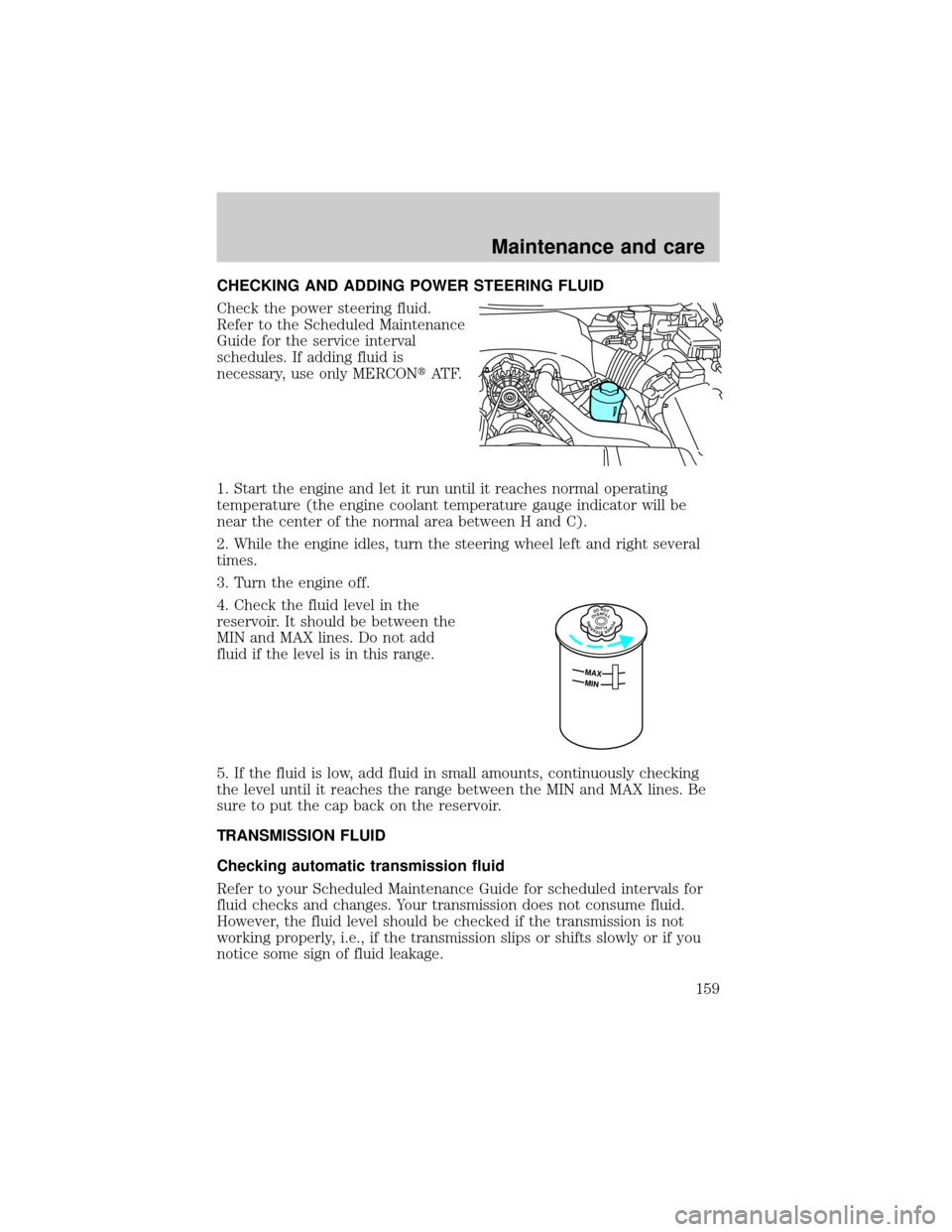
CHECKING AND ADDING POWER STEERING FLUID
Check the power steering fluid.
Refer to the Scheduled Maintenance
Guide for the service interval
schedules. If adding fluid is
necessary, use only MERCONtAT F.
1. Start the engine and let it run until it reaches normal operating
temperature (the engine coolant temperature gauge indicator will be
near the center of the normal area between H and C).
2. While the engine idles, turn the steering wheel left and right several
times.
3. Turn the engine off.
4. Check the fluid level in the
reservoir. It should be between the
MIN and MAX lines. Do not add
fluid if the level is in this range.
5. If the fluid is low, add fluid in small amounts, continuously checking
the level until it reaches the range between the MIN and MAX lines. Be
sure to put the cap back on the reservoir.
TRANSMISSION FLUID
Checking automatic transmission fluid
Refer to your Scheduled Maintenance Guide for scheduled intervals for
fluid checks and changes. Your transmission does not consume fluid.
However, the fluid level should be checked if the transmission is not
working properly, i.e., if the transmission slips or shifts slowly or if you
notice some sign of fluid leakage.
DONOTOVERFILLPOWERSTEERINGFLUID
MAX
MIN
Maintenance and care
159
Page 160 of 208
![FORD CROWN VICTORIA 1999 2.G Owners Manual Automatic transmission fluid expands when warmed. To obtain an
accurate fluid check, drive the vehicle until it is at normal operating
temperature (approximately 30 km [20 miles]). If your vehicle has FORD CROWN VICTORIA 1999 2.G Owners Manual Automatic transmission fluid expands when warmed. To obtain an
accurate fluid check, drive the vehicle until it is at normal operating
temperature (approximately 30 km [20 miles]). If your vehicle has](/manual-img/11/4775/w960_4775-159.png)
Automatic transmission fluid expands when warmed. To obtain an
accurate fluid check, drive the vehicle until it is at normal operating
temperature (approximately 30 km [20 miles]). If your vehicle has been
operated for an extended period at high speeds, in city traffic during hot
weather or pulling a trailer, the vehicle should be turned off for about 30
minutes to allow fluid to cool before checking.
1. Drive the vehicle 30 km (20 miles) or until it reaches normal operating
temperature.
2. Park the vehicle on a level surface and engage the parking brake.
3. With the parking brake engaged and your foot on the brake pedal,
start the engine and move the gearshift lever through all of the gear
ranges. Allow sufficient time for each gear to engage.
4. Latch the gearshift lever in P (Park) and leave the engine running.
5. Remove the dipstick, wiping it clean with a clean, dry lint free rag.
6. Install the dipstick making sure it is fully seated in the filler tube.
7. Remove the dipstick and inspect the fluid level. The fluid should be in
the designated area for normal operating temperature (H) or ambient
temperature (C).
Low fluid level
Do not drive the vehicle if the fluid
level is at the bottom of the dipstick
and the ambient temperature is
above 10ÉC (50ÉF).
Correct fluid level
The transmission fluid should be checked at normal operating
temperature 66ÉC-77ÉC (150ÉF-170ÉF) on a level surface. The normal
operating temperature can be reached after approximately 30 km (20
miles) of driving.
You can check the fluid without driving if the ambient temperature is
above 10ÉC (50ÉF). However, if fluid is added at this time, an overfill
condition could result when the vehicle reaches normal operating
temperature.
The transmission fluid should be in
this range if at normal operating
temperature (66ÉC-77ÉC
[150ÉF-170ÉF]).
DON’T ADD
DON’T ADD
Maintenance and care
160
Page 161 of 208
![FORD CROWN VICTORIA 1999 2.G Owners Manual The transmission fluid should be in
this range if at ambient temperature
(10ÉC-35ÉC [50ÉF-95ÉF]).
High fluid level
Fluid levels above the safe range
may result in transmission failure.
An overfill FORD CROWN VICTORIA 1999 2.G Owners Manual The transmission fluid should be in
this range if at ambient temperature
(10ÉC-35ÉC [50ÉF-95ÉF]).
High fluid level
Fluid levels above the safe range
may result in transmission failure.
An overfill](/manual-img/11/4775/w960_4775-160.png)
The transmission fluid should be in
this range if at ambient temperature
(10ÉC-35ÉC [50ÉF-95ÉF]).
High fluid level
Fluid levels above the safe range
may result in transmission failure.
An overfill condition of transmission
fluid may cause shift and/or
engagement concerns and/or
possible damage.
High fluid levels can be caused by
an overheating condition.
Adjusting automatic transmission fluid levels
Before adding any fluid, make sure the correct type is used. The type of
fluid used is normally indicated on the dipstick and/or dipstick handle
and also in theLubricant specificationssection in theCapacities and
specificationschapter.
Use of a non-approved automatic transmission fluid may cause
internal transmission component damage.
If necessary, add fluid in 250 mL (1/2 pint) increments through the filler
tube until the level is correct.
If an overfill occurs, excess fluid
should be removed by a qualified
technician.
An overfill condition of
transmission fluid may cause
shift and/or engagement
concerns and/or possible
damage.
DON’T ADD
DON’T ADD
DON’T ADD
Maintenance and care
161
Page 176 of 208
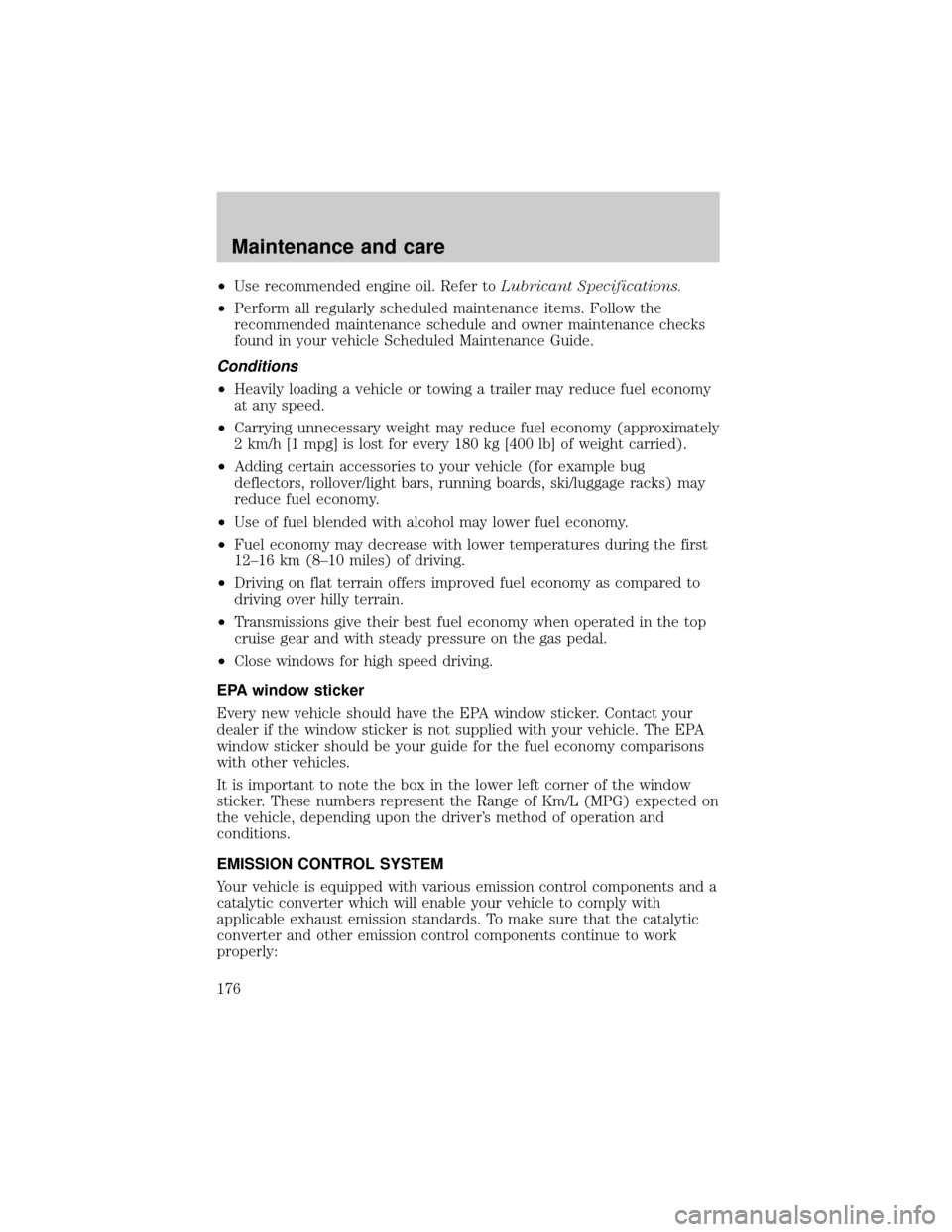
²Use recommended engine oil. Refer toLubricant Specifications.
²Perform all regularly scheduled maintenance items. Follow the
recommended maintenance schedule and owner maintenance checks
found in your vehicle Scheduled Maintenance Guide.
Conditions
²Heavily loading a vehicle or towing a trailer may reduce fuel economy
at any speed.
²Carrying unnecessary weight may reduce fuel economy (approximately
2 km/h [1 mpg] is lost for every 180 kg [400 lb] of weight carried).
²Adding certain accessories to your vehicle (for example bug
deflectors, rollover/light bars, running boards, ski/luggage racks) may
reduce fuel economy.
²Use of fuel blended with alcohol may lower fuel economy.
²Fuel economy may decrease with lower temperatures during the first
12±16 km (8±10 miles) of driving.
²Driving on flat terrain offers improved fuel economy as compared to
driving over hilly terrain.
²Transmissions give their best fuel economy when operated in the top
cruise gear and with steady pressure on the gas pedal.
²Close windows for high speed driving.
EPA window sticker
Every new vehicle should have the EPA window sticker. Contact your
dealer if the window sticker is not supplied with your vehicle. The EPA
window sticker should be your guide for the fuel economy comparisons
with other vehicles.
It is important to note the box in the lower left corner of the window
sticker. These numbers represent the Range of Km/L (MPG) expected on
the vehicle, depending upon the driver's method of operation and
conditions.
EMISSION CONTROL SYSTEM
Your vehicle is equipped with various emission control components and a
catalytic converter which will enable your vehicle to comply with
applicable exhaust emission standards. To make sure that the catalytic
converter and other emission control components continue to work
properly:
Maintenance and care
176
Page 187 of 208
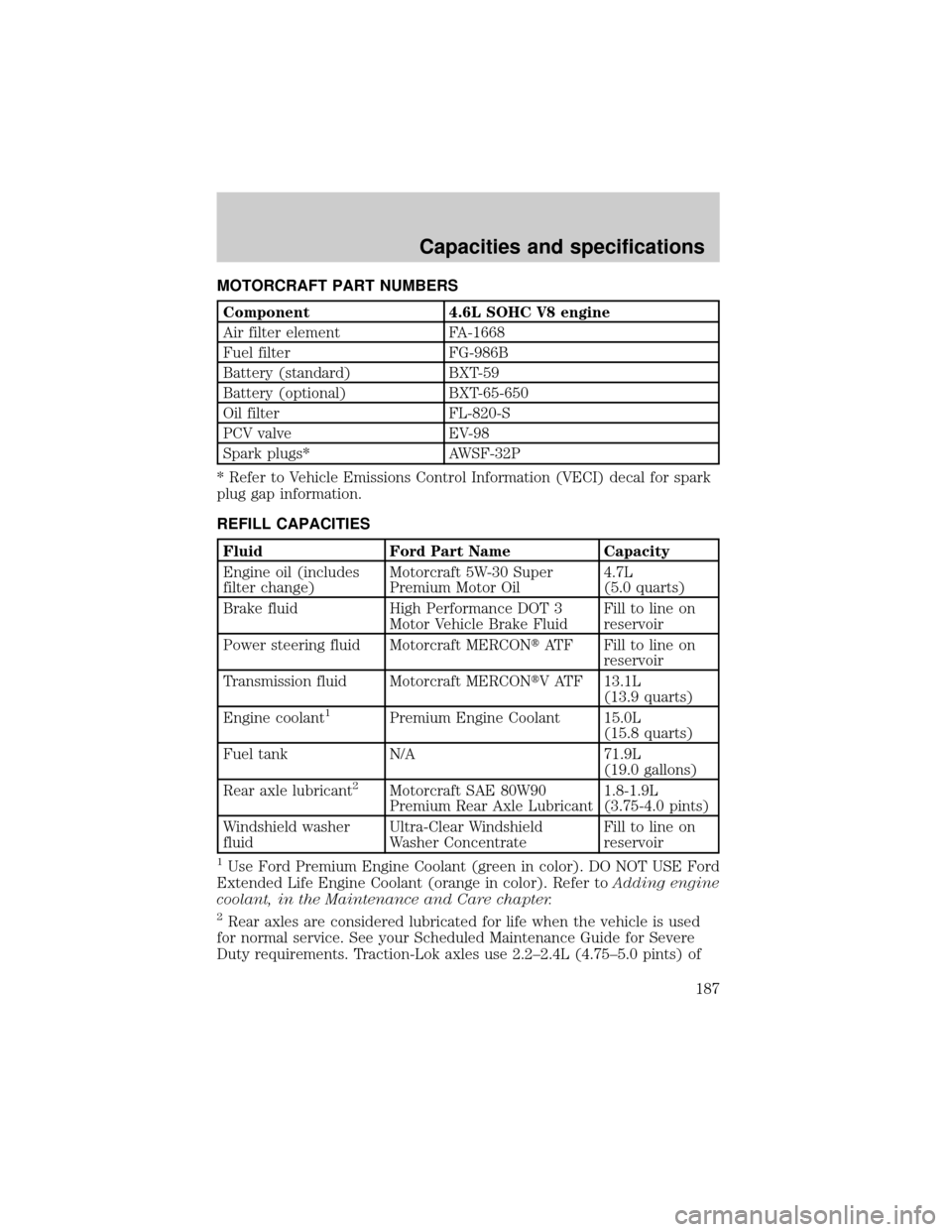
MOTORCRAFT PART NUMBERS
Component 4.6L SOHC V8 engine
Air filter element FA-1668
Fuel filter FG-986B
Battery (standard) BXT-59
Battery (optional) BXT-65-650
Oil filter FL-820-S
PCV valve EV-98
Spark plugs* AWSF-32P
* Refer to Vehicle Emissions Control Information (VECI) decal for spark
plug gap information.
REFILL CAPACITIES
Fluid Ford Part Name Capacity
Engine oil (includes
filter change)Motorcraft 5W-30 Super
Premium Motor Oil4.7L
(5.0 quarts)
Brake fluid High Performance DOT 3
Motor Vehicle Brake FluidFill to line on
reservoir
Power steering fluid Motorcraft MERCONtATF Fill to line on
reservoir
Transmission fluid Motorcraft MERCONtV ATF 13.1L
(13.9 quarts)
Engine coolant
1Premium Engine Coolant 15.0L
(15.8 quarts)
Fuel tank N/A 71.9L
(19.0 gallons)
Rear axle lubricant
2Motorcraft SAE 80W90
Premium Rear Axle Lubricant1.8-1.9L
(3.75-4.0 pints)
Windshield washer
fluidUltra-Clear Windshield
Washer ConcentrateFill to line on
reservoir
1Use Ford Premium Engine Coolant (green in color). DO NOT USE Ford
Extended Life Engine Coolant (orange in color). Refer toAdding engine
coolant, in the Maintenance and Care chapter.
2Rear axles are considered lubricated for life when the vehicle is used
for normal service. See your Scheduled Maintenance Guide for Severe
Duty requirements. Traction-Lok axles use 2.2±2.4L (4.75±5.0 pints) of
Capacities and specifications
187
Page 188 of 208
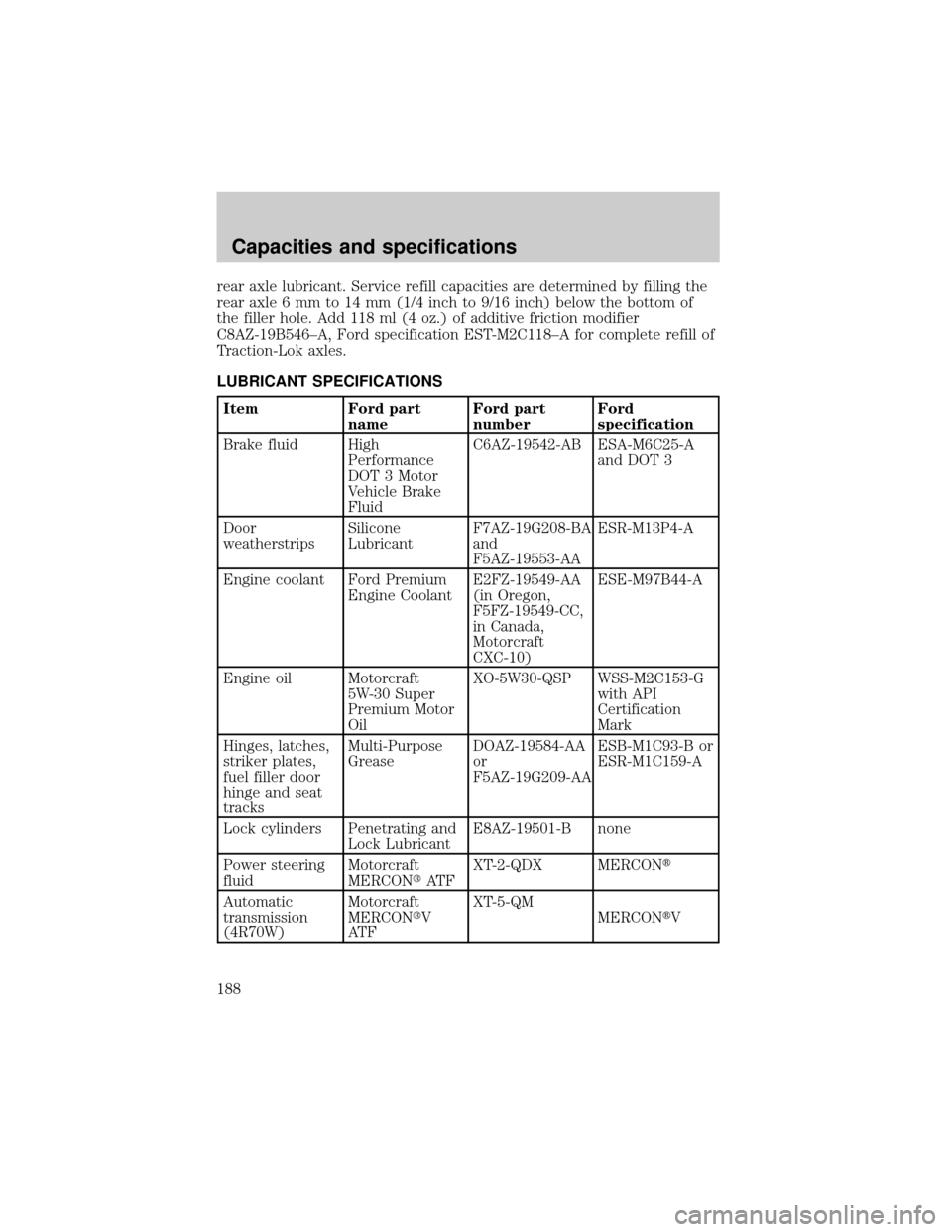
rear axle lubricant. Service refill capacities are determined by filling the
rear axle 6 mm to 14 mm (1/4 inch to 9/16 inch) below the bottom of
the filler hole. Add 118 ml (4 oz.) of additive friction modifier
C8AZ-19B546±A, Ford specification EST-M2C118±A for complete refill of
Traction-Lok axles.
LUBRICANT SPECIFICATIONS
Item Ford part
nameFord part
numberFord
specification
Brake fluid High
Performance
DOT 3 Motor
Vehicle Brake
FluidC6AZ-19542-AB ESA-M6C25-A
and DOT 3
Door
weatherstripsSilicone
LubricantF7AZ-19G208-BA
and
F5AZ-19553-AAESR-M13P4-A
Engine coolant Ford Premium
Engine CoolantE2FZ-19549-AA
(in Oregon,
F5FZ-19549-CC,
in Canada,
Motorcraft
CXC-10)ESE-M97B44-A
Engine oil Motorcraft
5W-30 Super
Premium Motor
OilXO-5W30-QSP WSS-M2C153-G
with API
Certification
Mark
Hinges, latches,
striker plates,
fuel filler door
hinge and seat
tracksMulti-Purpose
GreaseDOAZ-19584-AA
or
F5AZ-19G209-AAESB-M1C93-B or
ESR-M1C159-A
Lock cylinders Penetrating and
Lock LubricantE8AZ-19501-B none
Power steering
fluidMotorcraft
MERCONtAT FXT-2-QDX MERCONt
Automatic
transmission
(4R70W)Motorcraft
MERCONtV
AT FXT-5-QM
MERCONtV
Capacities and specifications
188
Page 191 of 208
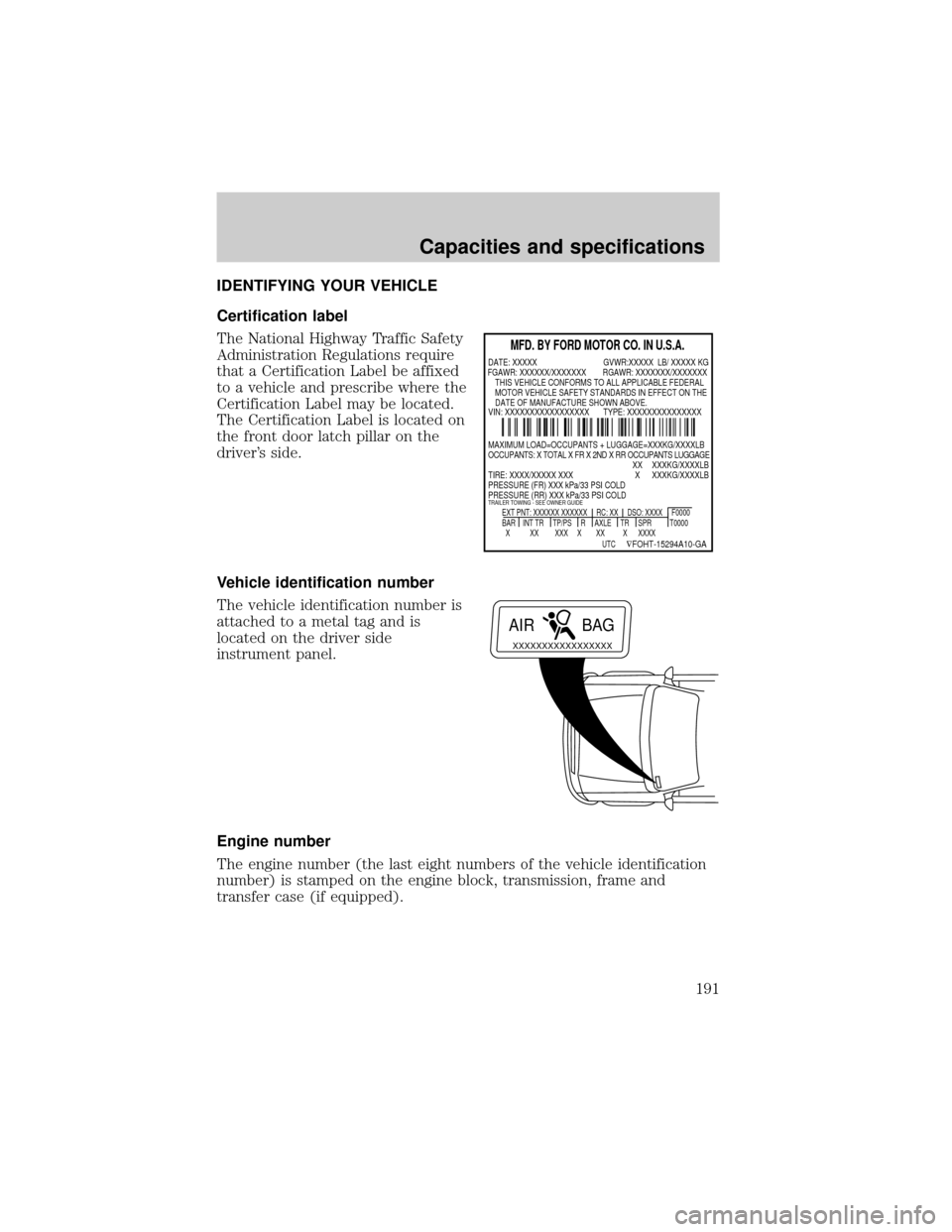
IDENTIFYING YOUR VEHICLE
Certification label
The National Highway Traffic Safety
Administration Regulations require
that a Certification Label be affixed
to a vehicle and prescribe where the
Certification Label may be located.
The Certification Label is located on
the front door latch pillar on the
driver's side.
Vehicle identification number
The vehicle identification number is
attached to a metal tag and is
located on the driver side
instrument panel.
Engine number
The engine number (the last eight numbers of the vehicle identification
number) is stamped on the engine block, transmission, frame and
transfer case (if equipped).
MFD. BY FORD MOTOR CO. IN U.S.A.
EXT PNT: XXXXXX XXXXXX RC: XX DSO: XXXX F0000
BAR INT TR TP/PS R AXLE TR SPR T0000
X XX XXX X XX X XXXX
UTC
ÑFOHT-15294A10-GA
MAXIMUM LOAD=OCCUPANTS + LUGGAGE=XXXKG/XXXXLB
OCCUPANTS: X TOTAL X FR X 2ND X RR OCCUPANTS LUGGAGE
XX XXXKG/XXXXLB
TIRE: XXXX/XXXXX XXX X XXXKG/XXXXLB
PRESSURE (FR) XXX kPa/33 PSI COLD
PRESSURE (RR) XXX kPa/33 PSI COLD
TRAILER TOWING - SEE OWNER GUIDE
DATE: XXXXX GVWR:XXXXX LB/ XXXXX KG
VIN: XXXXXXXXXXXXXXXXX TYPE: XXXXXXXXXXXXXXX FGAWR: XXXXXX/XXXXXXX RGAWR: XXXXXXX/XXXXXXX
THIS VEHICLE CONFORMS TO ALL APPLICABLE FEDERAL
MOTOR VEHICLE SAFETY STANDARDS IN EFFECT ON THE
DATE OF MANUFACTURE SHOWN ABOVE.
XXXXXXXXXXXXXXXXX
AIR BAG
Capacities and specifications
191
Page 205 of 208

Air bag supplemental
restraint system ........................101
and child safety seats ............102
description ..............................101
disposal ....................................105
indicator light .........................104
passenger air bag ...................103
Air conditioning
automatic temperature
control system ......27,28,29,30,32
Air suspension ...........................122
Anti-theft system ........................87
Automatic transmission
driving an automatic
overdrive ...................124,125,126
Axle
refill capacities ........................187
Brakes ........................................117
anti-lock ............................117,118
anti-lock brake system
(ABS) warning light ...............118
fluid, checking and adding ....153
shift interlock ..........................123
Break-in period .............................2
CD changer ..................61,63,64,65
Child safety seats
attaching with tether straps ..111
in rear seat .......................108,110
tether anchorage hardware ...111
Cleaning your vehicle ...............182
engine compartment ..............184
exterior .............................183,186
exterior lamps .........................185
interior .....................................186
plastic parts ............................185
washing ....................................183
waxing .....................................183
wheels ......................................184
windows ..................................186
wiper blades ............................185
Clock ............................................33
Compass, electronic ....................76calibration .................................77
set zone adjustment .................77
Controls ........................72,73,74,75
power seat ............................93,94
Coolant ......................................156
checking and adding ..............155
refill capacities ........................156
Customer Assistance
Ford accessories for
your vehicle ..............199,200,201
Ford Extended Service Plan .193
Getting assistance outside
the U.S. and Canada ..............198
Getting roadside assistance ...192
Getting the
service you need ....................194
Ordering additional
owner's literature ...................203
The Dispute Settlement
Board ..................195,196,197,198
Defrost
rear window ..............................24
Emission control system ..........176
Engine
check engine/
service engine soon light ...........7
coolant .....................................154
idle speed control ...................162
service points ..........................150
starting after a collision .........132
Engine block heater .................115
Engine oil
checking and adding ..............152
dipstick ....................................151
specifications ...................151,152
Exhaust fumes ..........................116
Fail safe cooling .................157,158
Floor mats ...................................81
Fuel
choosing the right fuel ...........171
comparisons with EPA fuel
economy estimates .................176
Index
205